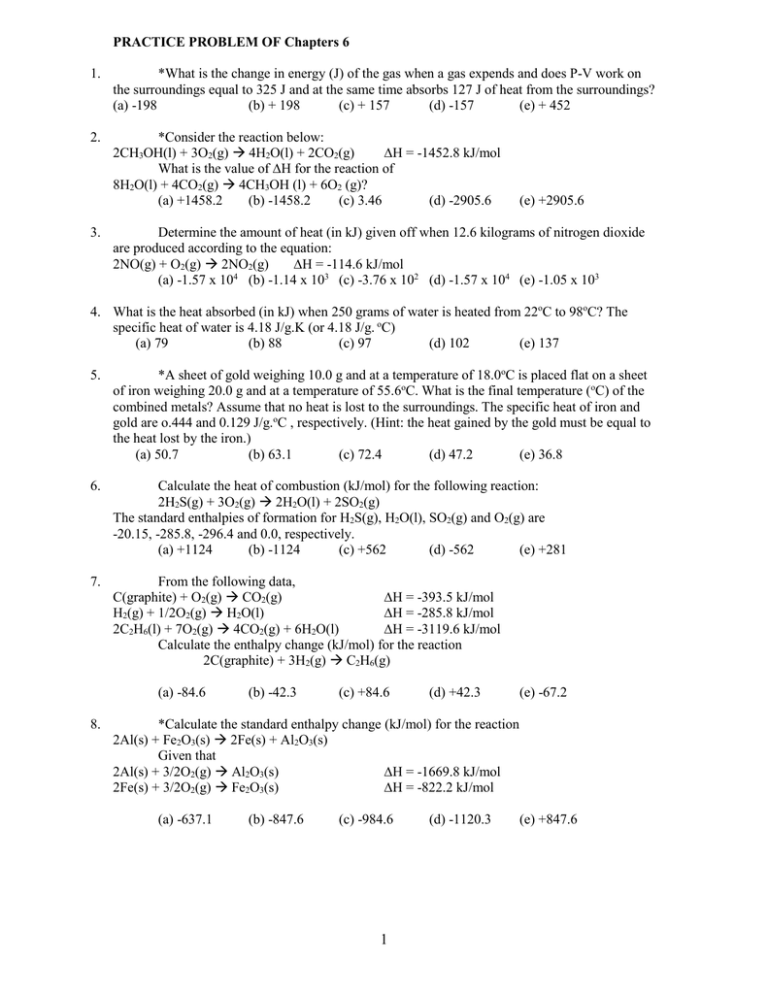Practice problem of chap6 in class.doc
advertisement

PRACTICE PROBLEM OF Chapters 6 1. *What is the change in energy (J) of the gas when a gas expends and does P-V work on the surroundings equal to 325 J and at the same time absorbs 127 J of heat from the surroundings? (a) -198 (b) + 198 (c) + 157 (d) -157 (e) + 452 2. *Consider the reaction below: 2CH3OH(l) + 3O2(g) 4H2O(l) + 2CO2(g) ∆H = -1452.8 kJ/mol What is the value of ∆H for the reaction of 8H2O(l) + 4CO2(g) 4CH3OH (l) + 6O2 (g)? (a) +1458.2 (b) -1458.2 (c) 3.46 (d) -2905.6 3. (e) +2905.6 Determine the amount of heat (in kJ) given off when 12.6 kilograms of nitrogen dioxide are produced according to the equation: 2NO(g) + O2(g) 2NO2(g) ∆H = -114.6 kJ/mol (a) -1.57 x 104 (b) -1.14 x 103 (c) -3.76 x 102 (d) -1.57 x 104 (e) -1.05 x 103 4. What is the heat absorbed (in kJ) when 250 grams of water is heated from 22oC to 98oC? The specific heat of water is 4.18 J/g.K (or 4.18 J/g. oC) (a) 79 (b) 88 (c) 97 (d) 102 (e) 137 5. *A sheet of gold weighing 10.0 g and at a temperature of 18.0oC is placed flat on a sheet of iron weighing 20.0 g and at a temperature of 55.6oC. What is the final temperature (oC) of the combined metals? Assume that no heat is lost to the surroundings. The specific heat of iron and gold are o.444 and 0.129 J/g.oC , respectively. (Hint: the heat gained by the gold must be equal to the heat lost by the iron.) (a) 50.7 (b) 63.1 (c) 72.4 (d) 47.2 (e) 36.8 6. Calculate the heat of combustion (kJ/mol) for the following reaction: 2H2S(g) + 3O2(g) 2H2O(l) + 2SO2(g) The standard enthalpies of formation for H2S(g), H2O(l), SO2(g) and O2(g) are -20.15, -285.8, -296.4 and 0.0, respectively. (a) +1124 (b) -1124 (c) +562 (d) -562 (e) +281 7. From the following data, C(graphite) + O2(g) CO2(g) ∆H = -393.5 kJ/mol H2(g) + 1/2O2(g) H2O(l) ∆H = -285.8 kJ/mol 2C2H6(l) + 7O2(g) 4CO2(g) + 6H2O(l) ∆H = -3119.6 kJ/mol Calculate the enthalpy change (kJ/mol) for the reaction 2C(graphite) + 3H2(g) C2H6(g) (a) -84.6 8. (b) -42.3 (c) +84.6 (d) +42.3 (e) -67.2 *Calculate the standard enthalpy change (kJ/mol) for the reaction 2Al(s) + Fe2O3(s) 2Fe(s) + Al2O3(s) Given that 2Al(s) + 3/2O2(g) Al2O3(s) ∆H = -1669.8 kJ/mol 2Fe(s) + 3/2O2(g) Fe2O3(s) ∆H = -822.2 kJ/mol (a) -637.1 (b) -847.6 (c) -984.6 1 (d) -1120.3 (e) +847.6






